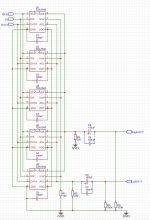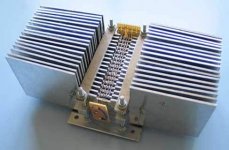Hello everyone.
I've been doing some reading and came across the TDA1543 DAC chip. From what I can tell it is the newest NOS chip made.
The chip itself has a S/N ratio of somewhere in the 90's, which by today's standards is not great. As I've been reading, it was mentioned that paralleling a bunch of these chips together will increase the sound quality.
I pondered up a simple schematic of 5 of these paralleled together with some output caps. The schematic is in the attachments section.
Here comes my questions:
1. How many TDA1543's need to be paralleled to sound good? I know "sound good" is a vague term though I've seen these paralleled with up to 60 chips. I would just like to know whats a good sweet-spot before they hit the point of diminishing return.
2. Some of the TDA1543 designs have a "re-clocker" which I am not sure if makes a noticeable sound benefit.
3. If the S/N ratio does increase proportional to the amount of chips added, how can that figure be calculated?
Any help would be greatly appreciated. Thanks everyone
I've been doing some reading and came across the TDA1543 DAC chip. From what I can tell it is the newest NOS chip made.
The chip itself has a S/N ratio of somewhere in the 90's, which by today's standards is not great. As I've been reading, it was mentioned that paralleling a bunch of these chips together will increase the sound quality.
I pondered up a simple schematic of 5 of these paralleled together with some output caps. The schematic is in the attachments section.
Here comes my questions:
1. How many TDA1543's need to be paralleled to sound good? I know "sound good" is a vague term though I've seen these paralleled with up to 60 chips. I would just like to know whats a good sweet-spot before they hit the point of diminishing return.
2. Some of the TDA1543 designs have a "re-clocker" which I am not sure if makes a noticeable sound benefit.
3. If the S/N ratio does increase proportional to the amount of chips added, how can that figure be calculated?
Any help would be greatly appreciated. Thanks everyone
Attachments
Last edited:
If you're looking for good sound, you can get that from a single TDA1543 but you need to pay attention to power supplies (low noise, low impedance) and also don't use the internal pull-up current source, rather create one yourself out of discrete transistors.
Seeing as the typical noise level of a single chip is 96dB you're going to be limited by the noise on your recording rather than that of the chip itself. But there may be gains from paralleling, I play with TDA1387 and that shows gains from using more than one chip in the right circuit. By 'the right circuit' I mean some form of active I/V either with discretes or ICs. The distortion also reduces by paralleling more chips as DAC bit-weight errors (which are quite considerable on this device) get averaged out.
As for calculations, the SNR - ratio of maximum signal level to the noise with no music playing - will improve by 3dB for each doubling of the number of chips.
Seeing as the typical noise level of a single chip is 96dB you're going to be limited by the noise on your recording rather than that of the chip itself. But there may be gains from paralleling, I play with TDA1387 and that shows gains from using more than one chip in the right circuit. By 'the right circuit' I mean some form of active I/V either with discretes or ICs. The distortion also reduces by paralleling more chips as DAC bit-weight errors (which are quite considerable on this device) get averaged out.
As for calculations, the SNR - ratio of maximum signal level to the noise with no music playing - will improve by 3dB for each doubling of the number of chips.
2. Some of the TDA1543 designs have a "re-clocker" which I am not sure if makes a noticeable sound benefit.
For my opp. yes it has? But You can try. Use 2 x serial flip-flop for each line, (not just one FF per digital line) and clock with Master Clock. All lines BCK, LE and DATA.
please note that in this output configuration You will have opposite phase at the output. Because Riv type of IV conversion.
IF You want signal in phase USE negative data from last Flip-Flop at the DATA ditial I2S line. You can use jumper from Q and -Q FF output for this...
cheers
1. How many TDA1543's need to be paralleled to sound good? I know "sound good" is a vague term though I've seen these paralleled with up to 60 chips. I would just like to know whats a good sweet-spot before they hit the point of diminishing return.
Long time ago I made 16 x TDA1543. One thing is crucial. Heat.
With 8 x You will have huge amount of dissipation. Consider some space for heat-sink. Bigger one. I think that sound is better when chips are cooler as can be. Happy building, and You will be not disappointed with sound, for sure.
I found some old photo of the stacked TDA1543 chips in sandwich heat-sinks. I tested for day and more non-stop in the summer high temperatures. And it was just warm in chasses after opening to check... Power supply active element have to be also on bigger heatsink, transformer have to be good and suficient and more power.
From the datas one chip have at 5V 50mA current consumtion at 8V supply it is 60mA
so count that it will be 8x0.06A=0.48mA these 0.5Ampers (cca.) have for instance drop at the active regulator element of say 5V then disipatino on the active power supply element will be 5V x 0.5A = 2.5W (count heatsink 4 x for 10W disip, if Yoy want to be just warm temp...)
With 16 x dacs all that is 2 x by numbers BUT heat is not linear, rather some exponential increase.
Cheers
From the datas one chip have at 5V 50mA current consumtion at 8V supply it is 60mA
so count that it will be 8x0.06A=0.48mA these 0.5Ampers (cca.) have for instance drop at the active regulator element of say 5V then disipatino on the active power supply element will be 5V x 0.5A = 2.5W (count heatsink 4 x for 10W disip, if Yoy want to be just warm temp...)
With 16 x dacs all that is 2 x by numbers BUT heat is not linear, rather some exponential increase.
Cheers
Attachments
Zoran,
Thanks for all the information, it will definitely come in useful.
Just out of curiosity would you happen to know your S/N ratio as well as distortion on your dac with 16 of those chips? Thanks,
Kaden
Thanks for all the information, it will definitely come in useful.
Just out of curiosity would you happen to know your S/N ratio as well as distortion on your dac with 16 of those chips? Thanks,
Kaden
Zoran,
Thanks for all the information, it will definitely come in useful.
Just out of curiosity would you happen to know your S/N ratio as well as distortion on your dac with 16 of those chips? Thanks,
Kaden
I didn't measure this at that time. Maybe 15 years ago, or more. But it is not worse than one chip used. Anyway it matters the power supply quality and wiring too. And digital bus quality, including clocking signals. Maybe even more. One is for sure, the output of 16X have significantly better "ear" performance, than one chip, and 8x pack.
I can give a tip for not using regulators in power supplies. Just classic (non-feedback transistor or darlington regulator. With shunt ends for digital branch. For DAC power shunt is welcome too - BUT the heat will be tremendous. I think that I supply TDA1543 with 8V. God rectification, C-R-C stage, and BJT regulator stage, all with quality elements will just do fine. Take a look at the one of the first examples of paralleling with tda1543? Kusunoki 4x1543. With a note to the power supply sections. My opinion is only that values of C in the power part are little too high.
- Home
- Source & Line
- Digital Line Level
- DIY TDA1543 DAC

